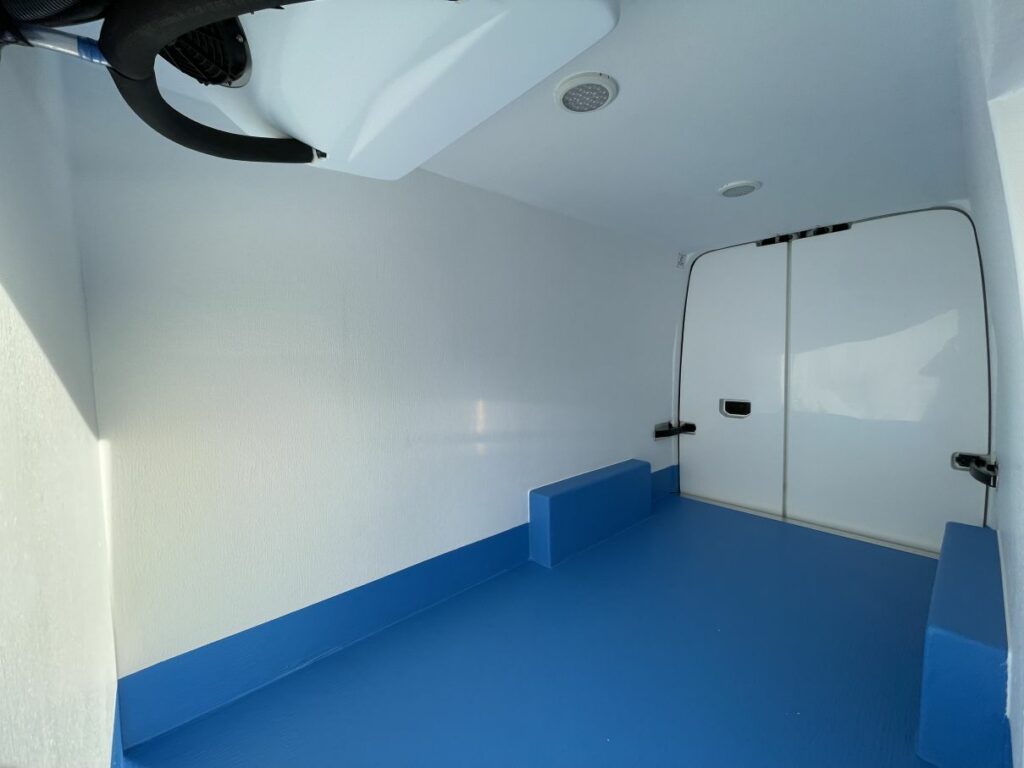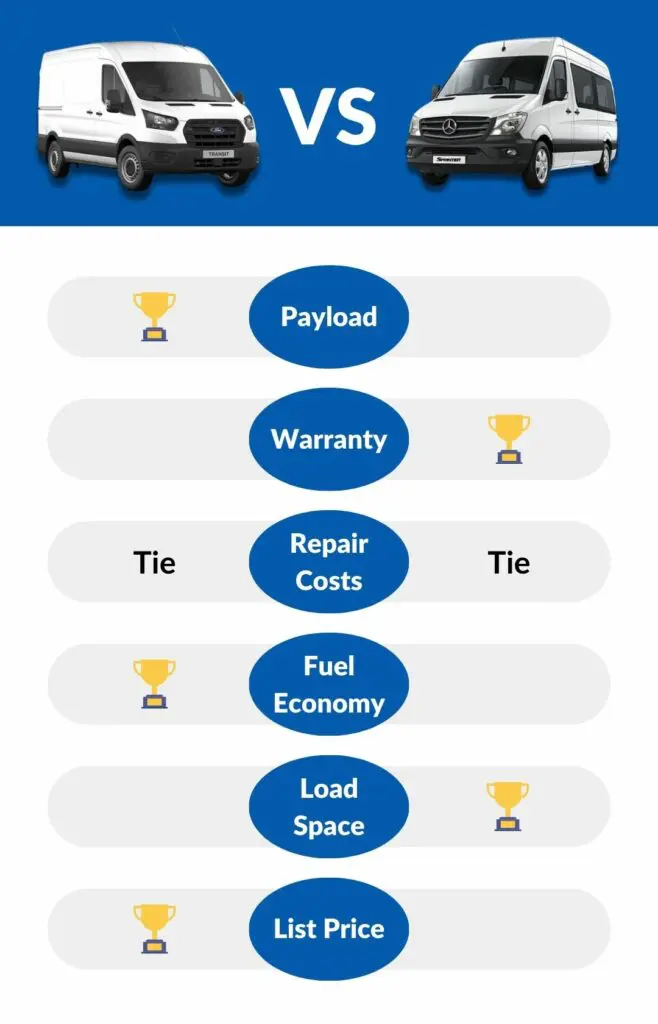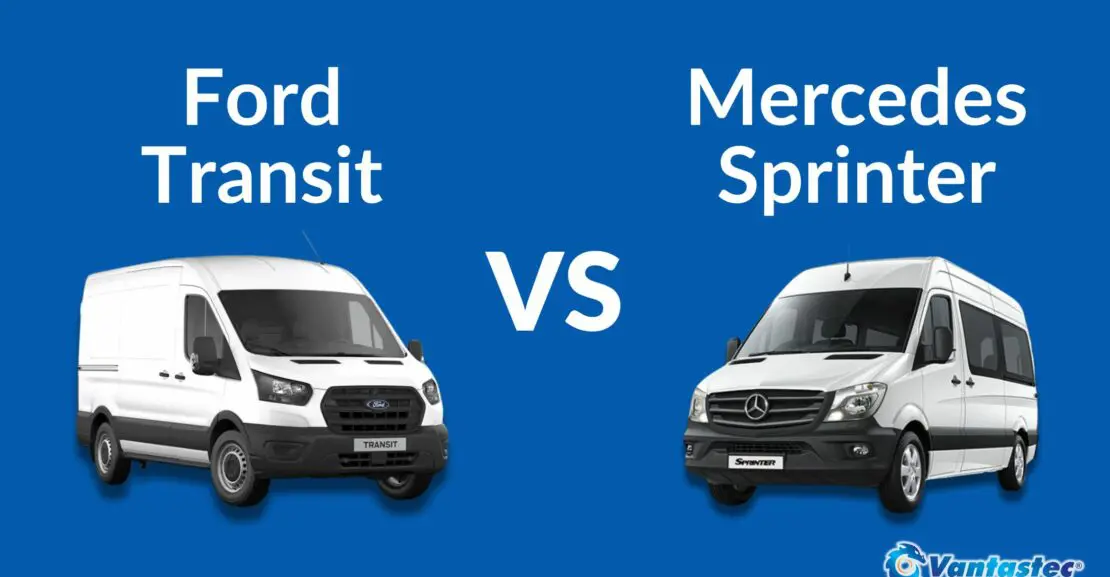Ford Transit vs Mercedes Sprinter: Which Van Should You Buy?
Ford Transit vs Mercedes Sprinter: which large van model should you pick? In this guide, we’ll be breaking down how they compare in seven key categories.
The Ford Transit and Mercedes Sprinter are two of the finest large van offerings available on the market today.
Each has earned acclaim from van buyers around the world – not just in the UK – for their versatility, driver experience and all-around performance.
From builders and tradesmen to refrigerated vehicle operators and even camper vans, both the Transit and Sprinter are relied on for a range of working-day applications.
But which one should you choose for your next project?
Hang tight, because we’ll be breaking down the Ford Transit vs Mercedes Sprinter and finding out which vehicle best suits your needs.
Contents:
- What we’re analysing and why
- Payload
- Manufacturer’s warranty
- Repairs & servicing costs
- Fuel economy
- Load area
- Retail price
- Summary
In Need Of A New Large Van? Click Here To Browse Our Stock
Methodology
First, a few housekeeping rules.
Van models come in plenty of sizes and engine variants. This is so manufacturers can create a product that suits more van users.
Performance data such as payloads, fuel efficiency, and load space will vary depending on the variant.
For example: a long-wheelbase van will, naturally, have more load space than a short-wheelbase one. Heavier vehicles with bigger engines also tend to be less fuel-efficient.
We don’t want to overwhelm you by presenting data for every variant in the manufacturer’s brochure. That would take up too much time.
Instead, we’ll be comparing one variant for each; as close in size and specification as possible for the fairest results.
Here are those variants:
- Ford Transit L3H2 2.0L Ford EcoBlue 130PS FWD
- Mercedes Sprinter 315 Van L3 H2 RWD
Second, we’ll only be comparing brand-new 2024 models using information from the manufacturers’ websites.
Third, we’ll be comparing L3H2 models only. These are the most popular size variants among van buyers, in our experience. Even though both variants carry the name ‘L3H2’, they’re not exactly comparable in size. More on that later, though…
Finally, Ford makes the Transit in both front and rear-wheel drive variants, whereas Mercedes only sells the Sprinter in the UK as rear-wheel drive. As the front-wheel drive Transit is the easiest to get hold of in the UK, we’ll be using that specific model for comparison.
If you simply have to have a rear-wheel drive vehicle, check out the Ford website for performance figures on RWD variants of the Transit as a lot of the data we’re about to present will be different.
With the boring bits out of the way, let’s get stuck in.
Payload
Simply put, the payload of a van is how much weight it can carry including all passengers.
Payload is one of the most important things to consider when choosing a new van – especially a larger one.
Manufacturers will outline the maximum payload for their vehicles in brochures and other marketing materials. This number shouldn’t be exceeded for several reasons.
Mainly, safety. A heavier vehicle is much more dangerous to pedestrians and more difficult to control.
Another reason is emissions. Overloading your van will make it more harmful to the environment.
From a mechanical perspective, exceeding your van’s maximum payload will also put unnecessary strain on components like the engine, gearbox, suspension, and more.
Road users can also be penalised up to £300 for overloading their vehicles, according to the DVSA.
With all those points in mind, here’s how the Transit and Sprinter’s payloads compare.
Mercedes Sprinter Payload
1,088 kg
Ford Transit Payload
1,366 kg
Payload Summary
The Ford Transit wins this category – quite comfortably, as well.
Seeing as the Transit and Sprinter both fall under the ‘large van’ banner, a payload of 1000 kg is the bare minimum you’d expect.
A near-300 kg difference payload is quite significant, though. Especially if you’re adding a conversion to your vehicle that uses heavy equipment.
So, if your decision between these two van models comes down to which can carry more, you’d be better off going with a Ford Transit.
Manufacturer’s Warranty

The beauty of buying a new van vs a used one is you benefit from having a full manufacturer’s warranty.
These warranties will cover the sudden failure of mechanical and electronic components outlined by the manufacturer. Such components include the engine and gearbox; two of the most expensive to fix.
For true peace of mind, they’re great to have. Different manufacturers offer different warranties, however, with varying coverage periods and mileage restrictions.
As a van buyer, the longer the warranty and more miles you can do while still being covered, the better.
With Ford and Mercedes setting industry standards for large vans, their warranties should too, right?
Let’s find out.
Mercedes Sprinter Manufacturer’s Warranty
3 years, unlimited mileage
Ford Transit Manufacturer’s Warranty
3 years, up to 100,000 miles
Warranties Summary
Mercedes wins this category.
An unlimited mileage warranty is a godsend for drivers who put their vans through their paces.
The average van covers 16,000 miles a year, according to Lombard. Even if you only clock 33,000 miles or under a year, Ford’s warranty will be sufficient.
However, if you’re registering over this amount – say, for example, you’re a courier – then Mercedes’ unlimited mileage warranty will suit you better.
Bonus: Ford Transit vs Mercedes Sprinter Reliability
But which van is considered more reliable, the Ford Transit or Mercedes Sprinter?
A Sprinter is the most reliable van you can buy, according to Fleet News’ 2023 FN50 report. Ford’s Transit ranked third for reliability in the same study.
Ford was also named the most reliable van manufacturer overall, which is impressive because they’re the largest manufacturer of light commercial vehicles in the UK.
Both the Sprinter and Transit are two great vans when it comes to reliability.
Repairs & Servicing Costs

As mentioned above, all brand-new vans will come with a manufacturer’s warranty.
However, certain ‘serviceable’ items are not covered under warranty and will need to be replaced or fixed when they wear.
Prices for these repairs will vary depending on geographical location, hourly labour rates, parts prices and more.
Plus, to keep your van working in tip-top condition, servicing it per the manufacturer’s recommended schedule is a must.
For the sake of this analysis, we’ve logged onto clickmechanic.com to see what independent mechanics local to Vantastec HQ would charge for certain repairs and services on both the Sprinter and Transit.
These prices won’t be the same as what you’re quoted by your local garage or main dealer. But it gives you an idea of the rough difference in repair costs between the two vans.
We strongly advise checking warranty terms and conditions before getting your van worked on by your local mechanic as well. Using non-compliant parts and fluids could void your warranty completely.
The safest bet is to take your van to a main dealer for all repairs and service work. But we understand main dealer work isn’t in everyone’s budget.
With that in mind, here are some rough repair/servicing costs for the Ford Transit vs Mercedes Sprinter.
Mercedes Sprinter Repair & Servicing Costs
Clutch replacement: £470.29 incl. VAT
Front brake disks and pads: £408.08 incl. VAT
Front shock absorbers (pair): £691.31 incl. VAT
Interim service: £253.96 incl. VAT
Full service: £307.30 incl. VAT
Major service: £360.67 incl. VAT
Ford Transit Repair & Servicing Costs
Clutch replacement: £311.66 incl. VAT
Front brake disks and pads: £611 incl. VAT
Front shock absorbers (pair): £617.81 incl. VAT
Interim service: £186.72 incl. VAT
Full service: £328.68 incl. VAT
Major service: £379.19 incl. VAT
Repair Costs Summary
These results are a mixed bag. While the Ford Transit – judging by the data – is cheaper to repair, the Mercedes Sprinter is cheaper to service.
The only major discrepancy in price is when it comes to replacing the clutch. If you or your drivers are known for ‘riding the clutch’, a Transit might be a better choice.
If you do ride your clutch, please stop. It’ll save you a lot of money.
On the flip side, if you do a lot of miles and need to change your oil more frequently, buying a Sprinter could be more cost-effective.
We can’t give you a definitive answer on which van is the cheapest to maintain. It’s too circumstantial.
We can, however, offer the following suggestion: it might be better to choose the van with a main dealer nearest to you.
That way, dropping your van off for warranty work and routine services becomes less of an inconvenience.
Seeing as both of these models rank highly in recent van reliability surveys, the chances of you needing to book them in for any warranty work would be slim anyway.
Fuel Economy

Next up in our Mercedes Sprinter vs Ford Transit comparison is fuel economy.
Arguably the greatest expense in owning a van – other than the vehicle itself – is fuel.
When your line of work heavily depends on driving far and wide, naturally, you’ll be spending a lot on fuel. If this sounds like you, buying a van that’ll drive you further for less is vital.
Fuel efficiency in vans has come by leaps and bounds in recent years. With each facelift and model refresh, engines are becoming more and more efficient.
But which of these two large vans has the best fuel efficiency (according to the manufacturers, at least)? Let’s find out.
Mercedes Sprinter Fuel Economy (WLTP)
Extra-urban: 26.4 mpg
Urban: 33.6 mpg
Rural: 35.3 mpg
Motorway: 26.6 mpg
Combined: 30 mpg
Ford Transit Fuel Economy (WLTP)
Extra-urban: 33.6 mpg
Urban: 38.7 mpg
Rural: 39.8 mpg
Motorway: 24.1 mpg
Combined: 32.5 mpg
Fuel Economy Summary
In terms of overall combined fuel economy figures, the Transit comes out on top.
While the Sprinter’s numbers show it to be a slightly more frugal van for motorway driving, the Transit wins based on its performance in urban and rural environments.
If most of your daily driving consists of sitting at traffic lights or cruising through built-up areas, get a Transit.
If you are solely blasting along motorways and dual carriageways for most of your days, a Sprinter could be more suitable.
Overall, though, the Transit gets our pick.
Load Area

Next up, load area.
The load area of a van, put simply, is the section in the back where you store your cargo.
We’d put load area up there alongside payload as one of the first things to consider when buying a new van. One of the first questions we ask our customers is ‘what size van do you need?’ or ‘how many pallets worth of cargo will you be transporting?’
Seeing as you’re reading this guide – talking specifically about large-sized vans – we’ll go out on a limb and say load area is pretty important to you; and that you need a lot of it.
A van’s total load area is measured in cubic metres. This is calculated using the following formula:
Length (L) x Width (W) x Height (H)
The bigger the number, the more space a van has.
But which one has a bigger load area: a Ford Transit or Mercedes Sprinter? Let’s find out.
Remember – these figures are for L3H2 variants of each vehicle, as per the manufacturers’ websites.
Mercedes Sprinter Load Area
Load floor length: 4,410 mm
Max width: 1,787 mm
Height: 2,009 mm
Load volume: 14 cubic metres
Ford Transit Load Area
Load floor length: 3,494 mm
Max width: 1,784 mm
Height: 1,886 mm
Load volume: 11.5 cubic metres
Load Area Summary
The Sprinter wins by a very comfortable margin. We can explain why.
Despite Ford marketing this variant as the ‘L3H2’ model, it’s actually more similar in size to a medium wheelbase equivalent of any other large van.
Whether it be a Nissan Interstar, VW Crafter, or, of course, a Mercedes Sprinter, both the external and internal dimensions of the L3H2 Ford Transit match up more fairly to medium wheelbase/L2H2 versions.
If you love the idea of owning a Transit, but simply need a load area similar in size to the Sprinter, you can always go for an L4H3 variant.
Payloads, pricing and fuel efficiency will be different than the figures featured in this guide, however.
If you need bigger again, you’d need to pick an L4/extra long wheelbase vehicle from a different manufacturer. L4H3 is the biggest you’ll get with a Transit, unfortunately.
Retail Price
Finally, price.
The most important consideration when buying any product, whether it be a van or even an apple from the supermarket, is price.
Van prices have sharply risen in recent years. A perfect storm of high demand and limited stock has inflated prices to astronomical levels.
Even converters like us are feeling the effects when purchasing new vehicles directly from the manufacturer.
As mentioned in the repairs/servicing section of this guide, list prices on these two models will be very circumstantial. Prices can vary from dealer to dealer, depending on the availability of stock and the demand for it.
But we can still use the list prices on the Ford and Mercedes websites to get a rough idea of how each of these models is priced.
NOTE: List prices are accurate at the time of writing and may be subject to fluctuation as per the manufacturer.
Ford Transit List Price
£43,975 excl VAT. (Leader spec)
Mercedes Sprinter List Price
£49,340 excl VAT. (Pro spec)
Retail Price Summary
The Transit wins again, coming in at just under £6000 plus VAT cheaper than the Sprinter.
In fairness to Mercedes, they’re widely considered to be one of the more ‘luxurious’ vehicle brands. For that, you’ll always pay a premium.
Generally, though, a Ford Transit will be much cheaper to buy.
Conclusion

So, Ford Transit vs Mercedes Sprinter: which one should you buy? It depends on what’s most important to you.
If fuel efficiency or price is your biggest concern, choose a Transit. If warranties or load areas are your priority, choose a Sprinter.
Both are great vans and are very capable of getting the job done – whatever that may be.
Just make sure you pick the one that best suits your needs.
Now, we’d love to hear your thoughts on the matter.
Have you owned a Ford Transit or Mercedes Sprinter? How was your experience? Do you have any questions or suggestions for topics you’d like us to cover next? Leave a comment below!
Read next:





